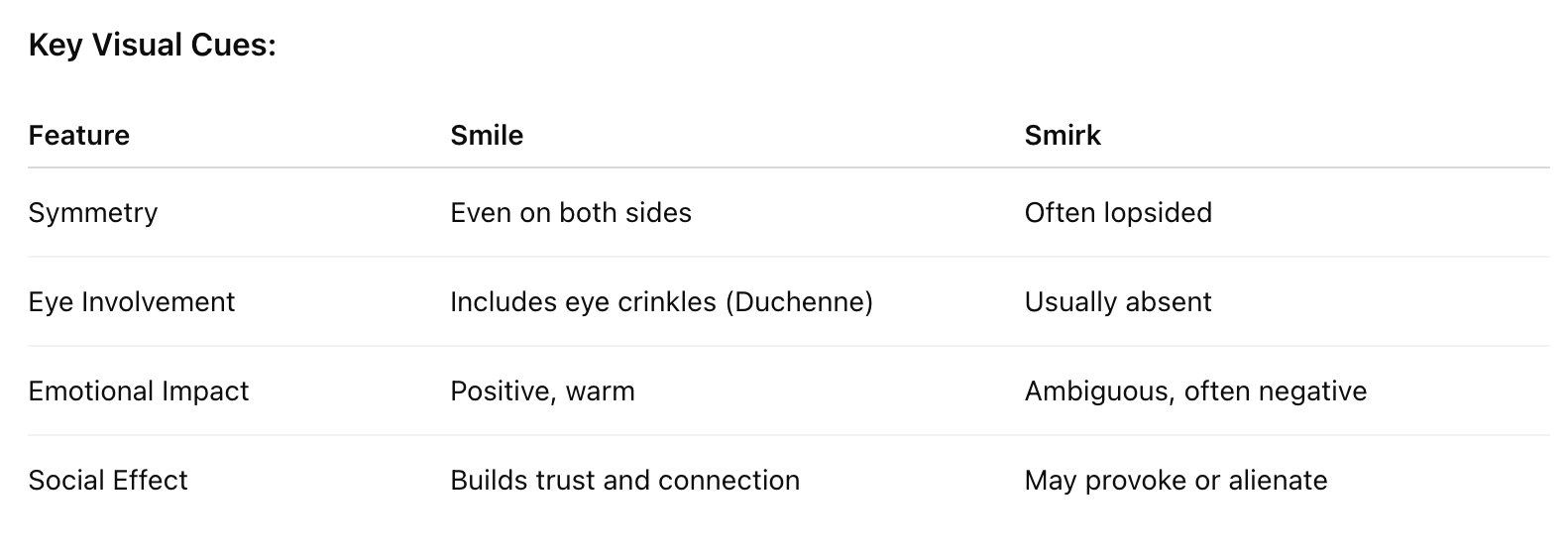Key Differences Between Smirk and Smile in Body Language
TL;DR: Smirk vs Smile – What’s the Difference?
A smile is a genuine, symmetrical facial expression that conveys warmth, joy, and friendliness—especially when it reaches the eyes (a Duchenne smile). A smirk, on the other hand, is a one-sided, often eye-less expression that can signal sarcasm, smugness, or contempt. While a smile invites connection, a smirk may create distance or suggest superiority. Reading the difference—especially in context and with other body language cues—can help you better understand others’ true emotions and intentions.
#TalkNerdyToMe® Staff Writer
Through body language we communicate effectively while sending signals beyond spoken words. Among the many facial expressions we use, the smirk and the smile stand out, yet their meanings are often confused. Accurate understanding of these two expressions enables correct interpretation of emotional responses and intentions in different social situations. The smile usually indicates positive feelings yet the smirk reveals multiple hidden meanings which include sarcasm and smugness as well as contempt.
The following analysis examines both the psychological and cultural along with interpersonal aspects of these two expressions. The article concludes with enhanced abilities to detect hidden meanings through facial expressions.
Understanding the Smirk
Definition of a Smirk
The smirk represents a particular type of smile which differs from authentic smiles since it manifests self-contentment rather than happiness. A smirk appears when someone lifts one corner of their mouth which produces an incomplete smile. The expression appears from one side of the mouth while remaining short and producing uncertainty about its meaning.
The meaning behind a smirk is layered. A smirk demonstrates sarcasm through irony in specific situations although it can also express superiority and contempt or mockery towards others. People usually do not mistake a smirk for a genuine expression of positive emotions.
Psychological Implications of Smirking
The psychological evaluation of smirk expressions shows how they reveal multiple emotional states. People might not notice they are smirking but their facial expressions unintentionally display emotions which differ from their verbal messages.
For example:
During conflict, a smirk might emerge as a form of non-verbal defiance or scorn.
Within social structures smirking serves as an unobtrusive method for displaying dominance or gaining power.
A smirk accompanies sarcastic or witty statements to function as the final part of the joke.
According to psychologist Paul Ekman the term "duping delight" describes this psychological phenomenon. The term describes the feeling of satisfaction people experience when they successfully deceive others which can manifest as a smirk.
The expression of contempt through a smirk
Contempt stands as a powerful feeling which people conceal with discreet body language. The smirk represents one of the most recognizable signs among the various contemptuous expressions. According to Ekman the smirk serves as a facial indicator for contempt which displays as one-sided lip elevation. This emotion is one of the seven universal emotions as defined by Ekman.
Interpersonal situations reveal the following indicators through a smirk:
Disrespect
Moral judgment
Intellectual superiority
When one person smirks at another during an argument it creates the perception of disrespect even though no words were exchanged. The smirk ranks as a highly confrontational facial expression in social settings.
The Nature of a Smile
Definition of a Smile
The facial expression known as a smile occurs when people use their mouth and eye muscles to flex their facial muscles. The expression reveals different emotional states such as:
Joy
Amusement
Affection
Politeness
Gratitude
The Duchenne smile which gets its name from French neurologist Guillaume Duchenne requires both facial corners to smile with the orbicularis oculi muscles engaging around the eyes. A Duchenne smile represents genuine authenticity because it engages both the mouth and eyes. A fake smile which people call "social" only affects the mouth muscles without engaging the eyes to show authenticity.
Psychological Benefits of Smiling
The human body experiences both psychological and physical effects when a person smiles through their face.
Research indicates that smiling produces several health benefits.
Lower blood pressure
The body reduces stress through lower cortisol production.
Boost immune function
Smiling causes an increase in endorphins which results in better mood quality.
Social bonds strengthen and group trust grows through smiling.
The facial feedback hypothesis from neuroscience demonstrates how facial expressions influence emotional experiences. Your forced smile at first will transform into genuine happiness because of the act of smiling.
Positive Interpretation of a Smile
Most people understand a natural smile as a positive sign which shows friendliness. This behavior functions in several ways for social interactions.
It helps to establish rapport during initial conversations
A smile helps to calm the atmosphere during challenging moments
Professional settings gain rapport through the use of this smile.
It indicates thanks along with showing appreciation.
Research across different cultures demonstrates that smiling functions as a prosocial behavior which builds relationships and strengthens social connections. People from different cultures may smile differently but the general interpretation of smiles as positive expressions is commonly accepted.
Comparing Smirk and Smile
Body Language Differences
The movement of both mouth and eyes happens symmetrically during a smile.
A smirk shows its impact on one side of the face while the eyes remain unaffected.
People exhibit genuine smiles in open ways which promotes others to approach them. Smirks create feelings of exclusion which produces distance or competition in relationships.
Contextual Meaning of Each Expression
Context is everything in body language. The same facial expression can mean different things in varying settings. For example:
In a job interview, a smile can signal enthusiasm and confidence, while a smirk might come across as arrogance.
During a heated debate, a smile may be interpreted as composure, while a smirk could be taken as condescension.
In romantic or flirtatious scenarios, a subtle smirk might add a sense of mystery or playfulness.
Understanding context helps decode the true emotional message. Is the person smirking because they’re confident—or because they’re mocking you?
Grin: A Middle Ground?
A grin occupies an interesting middle ground between a smile and a smirk. It’s often broader than a smile and conveys strong amusement or joy. However, unlike a smirk, it doesn’t usually carry negative connotations.
That said, a mischievous grin can blur the line. Depending on the situation, it might be interpreted as:
Playful ("I know something you don’t.")
Cheeky ("I’m pushing the boundaries.")
Subversive ("I’m enjoying the chaos.")
The tone, body posture, and verbal cues accompanying a grin will heavily influence its interpretation.
Interpreting Body Language in Real Life
How to Recognize a Smirk in Context
To spot a smirk, look for:
A one-sided lift of the lips
Lack of crinkling around the eyes
A posture that may include crossed arms or tilted head
Timing: If the expression arises during someone else’s misstep, it may signal schadenfreude (pleasure at another's misfortune)
Pay attention to microexpressions, which are fleeting facial expressions that reveal a person’s true emotions. A quick smirk might flash across someone’s face before they return to a neutral or pleasant expression.
Understanding Smiles in Social Interactions
Smiles are more than emotional expressions—they’re social tools. In professional settings, smiling appropriately can make you appear more competent, likable, and trustworthy.
But be careful of inauthentic smiles. These can be interpreted as:
Disingenuous
Manipulative
Socially obligatory
A true, meaningful smile should match the tone of the conversation and the speaker's body language. If someone smiles while their posture is closed off or they avoid eye contact, it may suggest discomfort or a lack of genuine emotion.
Positive vs Negative Body Language Cues
Reading body language accurately involves looking at clusters of cues rather than isolated signals.
Positive Body Language:
Open posture
Eye contact
Genuine smiles
Leaning slightly forward
Relaxed facial expressions
Nodding in agreement
These cues signal receptiveness, confidence, and interest.
Negative Body Language:
Crossed arms
Avoiding eye contact
Tension in the jaw or neck
Fidgeting
Fake smiles or smirks
Leaning away
These often indicate defensiveness, discomfort, or disinterest.
When evaluating whether a smirk or smile is genuine, consider the entire context—facial expressions, tone of voice, body position, and situation. People don’t communicate in isolated gestures, and facial expressions are only one part of the puzzle.
Cultural Variations in Expression
The interpretation of facial expressions which includes both smiles and smirks shows differences across different cultural groups.
For example:
Western cultures typically view smiling as an indicator of friendly behavior.
In certain East Asian societies people use smiling as a way to conceal their distress or feelings of embarrassment.
Smirking exists as a facial expression with negative meanings across cultures although its exact meaning depends on social norms in different societies.
The interpretation of facial expressions requires knowledge about cultural differences when working with people from various backgrounds in globalized workplaces and multicultural environments.
Conclusion: Why It Matters
The ability to distinguish between a smirk and a smile serves as a critical skill which benefits both professional and personal relationships. Facial expressions which seem insignificant can transform the complete meaning of any social interaction.
A smile invites connection and trust. A smirk functions as an expression that pushes people apart while displaying dominance over others. Your ability to read facial cues in combination with posture and tone and context helps you handle social situations better and prevent miscommunication.
Understanding the tiny facial expressions in our interactions will provide you with an advantage in building relationships as well as conflict resolution in our increasingly nonverbal world.




